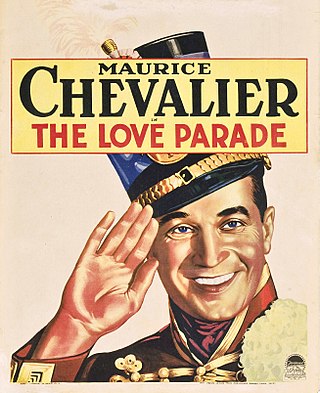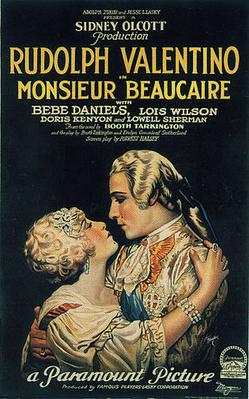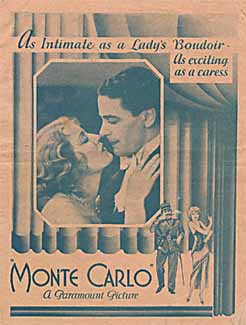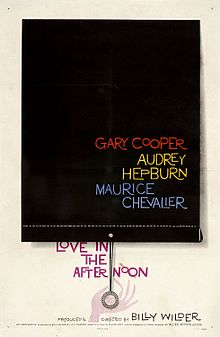
Billy Wilder was an Austrian-born filmmaker. His career in Hollywood spanned five decades, and he is regarded as one of the most brilliant and versatile filmmakers of Classic Hollywood cinema. He received seven Academy Awards, a BAFTA Award, the Cannes Film Festival's Palme d'Or and two Golden Globe Awards.

The Smiling Lieutenant is a 1931 American pre-Code musical comedy film directed by Ernst Lubitsch, starring Maurice Chevalier, Claudette Colbert and Miriam Hopkins, and released by Paramount Pictures.

Maurice Auguste Chevalier was a French singer, actor, and entertainer. He is perhaps best known for his signature songs, including "Livin' In The Sunlight", "Valentine", "Louise", "Mimi", and "Thank Heaven for Little Girls", and for his films, including The Love Parade, The Big Pond, The Smiling Lieutenant, One Hour with You, and Love Me Tonight. His trademark attire was a boater hat and tuxedo.

The Love Parade is a 1929 American pre-Code musical comedy film, directed by Ernst Lubitsch and starring Maurice Chevalier and Jeanette MacDonald, involving the marital difficulties of Queen Louise of Sylvania (MacDonald) and her consort, Count Alfred Renard (Chevalier). Despite his love for Louise and his promise to be an obedient husband, Count Alfred finds his role as a figurehead unbearable. The supporting cast features Lupino Lane, Lillian Roth and Eugene Pallette.

Ninotchka is a 1939 American romantic comedy film made for Metro-Goldwyn-Mayer by producer and director Ernst Lubitsch and starring Greta Garbo and Melvyn Douglas. It was written by Billy Wilder, Charles Brackett, and Walter Reisch, based on a screen story by Melchior Lengyel. Ninotchka is Greta Garbo's first full comedy, and her penultimate film; she received her third and final Academy Award nomination for Best Actress. In 1990, Ninotchka was selected for preservation in the United States National Film Registry by the Library of Congress as being "culturally, historically, or aesthetically significant". In 2011, Time also included the film on the magazine's list of "All-Time 100 Movies".

Ernst Lubitsch was a German-born film director, producer, writer, and actor. His urbane comedies of manners gave him the reputation of being Hollywood's most elegant and sophisticated director; as his prestige grew, his films were promoted as having "the Lubitsch touch". Among his best known works are Trouble in Paradise (1932), Design for Living (1933), Ninotchka (1939), The Shop Around the Corner (1940), To Be or Not to Be (1942) and Heaven Can Wait (1943).

William Franklin Holden was an American actor and one of the biggest box-office draws of the 1950s. Holden won the Academy Award for Best Actor for the film Stalag 17 (1953) and the Primetime Emmy Award for Outstanding Lead Actor in a Limited or Anthology Series or Movie for the television miniseries The Blue Knight (1973). Holden starred in some of Hollywood's most popular and critically acclaimed films, including Sunset Boulevard (1950), Sabrina (1954), Picnic (1955), The Bridge on the River Kwai (1957), The Wild Bunch (1969) and Network (1976). He was named one of the "Top 10 Stars of the Year" six times, and appeared as 25th on the American Film Institute's list of 25 greatest male stars of Classical Hollywood cinema.

Paris When It Sizzles is a 1964 American romantic comedy film directed by Richard Quine from a screenplay by George Axelrod, based on the 1952 French film Holiday for Henrietta by Julien Duvivier and Henri Jeanson. The film stars William Holden and Audrey Hepburn, with Grégoire Aslan, Raymond Bussières, Noël Coward, and Tony Curtis.

Sabrina is a 1954 American romantic comedy-drama film directed by Billy Wilder, from a screenplay he co-wrote with Samuel A. Taylor and Ernest Lehman, based on Taylor's 1953 play Sabrina Fair. The picture stars Humphrey Bogart, Audrey Hepburn, and William Holden. This was Wilder's last film released by Paramount Pictures, ending a 12-year business relationship between him and the company.
Givenchy is a French luxury fashion and perfume house. It hosts the brand of haute couture and ready-to-wear clothing, accessories, perfumes and cosmetics of Parfums Givenchy. The house of Givenchy was founded in 1952 by designer Hubert de Givenchy and is a member of Chambre Syndicale de la Haute Couture et du Prêt-à-Porter. It is currently owned by luxury conglomerate LVMH.

Monsieur Beaucaire is a 1924 American silent romantic historical drama film starring Rudolph Valentino in the title role, Bebe Daniels, and Lois Wilson. Produced and directed by Sidney Olcott, the film is based on Booth Tarkington's 1900 novel of the same name and the 1904 play of the same name by Tarkington and Evelyn Greenleaf Sutherland.

Gypsy Nash is a fictional character from the Australian Channel Seven soap opera Home and Away, played by Kimberley Cooper. She debuted on-screen during the episode airing on 18 February 1998. Gypsy and her on-screen family the Nashes were introduced to fill the void of Debra Lawrance's departure as Pippa Ross, to form the main family at the caravan park home, often described as "the centre of Summer Bay". Cooper quit the serial in 2001 and last appeared on 15 February 2002. Cooper has won two awards for her portrayal of Gypsy and is often referred to as a "sex symbol" of the serial. In June 2011, it was announced that Cooper had reprised her role as Gypsy. She returned on 9 September 2011 and departed on 13 October 2011.
The 15th Golden Globe Awards, honoring the best in film for 1957 films, were held on February 22, 1958.

Bluebeard's Eighth Wife is a 1938 Paramount Pictures American romantic comedy film directed and produced by Ernst Lubitsch and starring Claudette Colbert and Gary Cooper. The film is based on the 1921 French play La huitième femme de Barbe-Bleue by Alfred Savoir and the English translation of the play by Charlton Andrews. The screenplay was the first of many collaborations between Charles Brackett and Billy Wilder. The film is a remake of the 1923 silent version directed by Sam Wood and starring Gloria Swanson.

Monte Carlo is a 1930 American pre-Code musical comedy film, directed by Ernst Lubitsch. It co-stars Jack Buchanan as a French Count Rudolph Falliere masquerading as a hairdresser and Jeanette MacDonald as Countess Helene Mara. The film is notable for introducing the song "Beyond the Blue Horizon", which was written for the film and is first performed by MacDonald and a chorus on the soundtrack as she escapes on the train through he countryside. Monte Carlo was hailed by critics as a masterpiece of the newly emerging musical film genre. The screenplay was based on the Booth Tarkington novel Monsieur Beaucaire.

Audrey Hepburn was a British actress who had an extensive career in film, television, and on the stage from 1948 to 1993. Considered by some to be one of the most beautiful women of all time, she was ranked as the third greatest screen legend in American cinema by the American Film Institute. Hepburn is also remembered as both a film and style icon. Her debut was as a flight stewardess in the 1948 Dutch film Dutch in Seven Lessons. Hepburn then performed on the British stage as a chorus girl in the musicals High Button Shoes (1948), and Sauce Tartare (1949). Two years later, she made her Broadway debut as the title character in the play Gigi. Hepburn's Hollywood debut as a runaway princess in William Wyler's Roman Holiday (1953), opposite Gregory Peck, made her a star. For her performance, she received the Academy Award for Best Actress, the BAFTA Award for Best British Actress, and the Golden Globe Award for Best Actress in a Motion Picture – Drama. In 1954, she played a chauffeur's daughter caught in a love triangle in Billy Wilder's romantic comedy Sabrina, opposite Humphrey Bogart and William Holden. In the same year, Hepburn garnered the Tony Award for Best Actress in a Play for portraying the titular water nymph in the play Ondine.

Ariane is a 1931 German drama film directed by Paul Czinner and starring Elisabeth Bergner, Rudolf Forster and Annemarie Steinsieck. It is an adaptation of the 1920 French novel Ariane, jeune fille russe by Claude Anet. Two alternative language versions The Loves of Ariane and Ariane, jeune fille russe were made at the same time. The film was the inspiration of the 1957 Billy Wilder film Love in the Afternoon. Wilder remembered the film as "touching and funny". It was shot at the Staaken Studios in Berlin. The film's sets were designed by the art directors Erich Zander and Karl Weber. Location shooting took place in Paris.
Ariane, jeune fille russe is a 1920 novel by the French tennis player and writer Jean Schopfer, published under the pseudonym Claude Anet. It follows a young Russian woman who encounters a Don Juan and falls in love with him.

Carmen is a 1918 German silent drama film directed by Ernst Lubitsch and starring Pola Negri, Harry Liedtke, and Leopold von Ledebur. It was based on the novella Carmen by Prosper Mérimée. Like Bizet's opera Carmen, this film only adapts the third part of Mérimée's novella and transforms the character of Don José at the beginning of the story from bandit on the run to honest man in love with his childhood sweetheart. The film was released with English intertitles in the United States in 1921 under the alternative title Gypsy Blood.

Mr Wilder and Me is a novel by Jonathan Coe, published in the UK by Viking Books on 5 November 2020. It is a historical novel set in the late 1970s, and tells the story of Hollywood director Billy Wilder's struggles to write, finance and shoot his penultimate film Fedora, as observed through the eyes of a young Greek interpreter. The novel contains a mixture of real and invented characters.



















